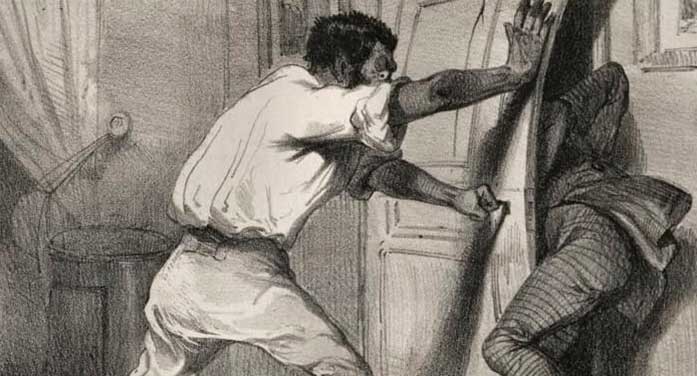
When people think of their favourite comic strips, they typically list the ones they remember reading as a child – or, in some cases, still read today. My preference has always been for the comics of yesteryear.
The early political cartoons of William Hogarth (A Rake’s Progress, 1732-34) and Francis Barlow (A True Narrative of the Horrid Hellish Popish Plot, 1682), for instance. The memorable work of James Gillray (The Plumb-pudding in danger: – or – State Epicures taking un Petit Souper, 1805), George Cruikshank (A Radical Reformer, 1819) and the great Benjamin Franklin (Join, or Die, 1754). Nineteenth-century humour and satire magazines contained illustrations and cartoons like Puck, Punch, Judge and Fun.
When it comes to humour comics, my list is exhaustive. Here are several examples: Wilhelm Busch’s Max und Moritz, Richard F. Outcault’s Hogan’s Alley, Buster Brown and Around the World with the Yellow Kid, Winsor McCay’s Little Nemo in Slumberland and Dream of the Rarebit Fiend and many, many more.
This brings us to David Kunzle.
The professor emeritus of art history at the University of California is one of the foremost experts on 19-century comic strips and contemporary comics scholarship. During COVID-19, I read his superb book, Father of the Comic Strip: Rodolphe Töpffer (2007).
 |
| MORE IN BOOKS |
| Hereditary empires and the struggle with modernity By Pat Murphy |
| How to maximize the meaning in our lives By Gerry Chidiac |
| New cookbook boosts protein diet to help people beat cancer By Bev Betkowski |
The Swiss-born Töpffer is one of the earliest-known 19th-century European cartoonists. He created the text comic/sequential picture book Histoire de M. Vieux Bois in 1837, which was reprinted in England as The Adventures of Mr. Obadiah Oldbuck in 1841. It also became America’s first comic book seven years later.
With the kind assistance of Courtney McCreary and the University Press of Mississippi, I now possess three more volumes of Kunzle’s work. They’re just as well-written and immaculately researched as his study of Töpffer.
Gustave Doré: Twelve Comic Strips (2015) is a magnificent introduction to the most “neglected” of the “masters of the 19-century comic strip.” While his paintings and illustrations are well known, he drew these lesser-known strips for Charles Philipon’s Journal pour Rire (The Laughter Journal) when he was between 15 and 22 years old. Kunzle’s book was the first extensive English language study of Doré’s comics.
Each strip was a work of art in its own right. Les Travaux d’Hercule (1847) was drawn when he was only 15. He sought to “recreate a famous story” by taking the position of a “parodist of heroic action, which is fast and furious, frenzied and foolish.”
There’s also L’Homme aux Cent Mille Écus (1850), an impressive text comic strip that contained what Kunzle described as a “mixed montage” due to its “constant shift in scene size, perspective and viewpoint.”
Voyage en Allemagne/Voyage sur le Rhin (1851) portrays Doré as a “diminutive and plump” young tourist exposed to “rowdy students, angry Prussian officers,” and more.
Cham: The Best Comic Strips and Graphic Novelettes, 1839-1862 (2019) is a scintillating volume about the life and work of French caricaturist Charles Amédée de Noé. Once a well-known figure in France, the cartoonist known as Cham has since become a “célèbre inconnu, a famous nonentity, now virtually unknown.” Kunzle aimed to change this with an enormous study of a man believed to have created over 40,000 comics.
Born into an aristocratic family, Cham started out as a disciple of Töpffer and later created his own farcical and absurd style, comédie humaine. The drawings are stunning, and the writing often contains real wit and humour. Exceptional stories in this book include L’Art d’Engraisser et de Maigrir à Volonté (1856), History de Mr. Jobard (1835) and Proudhon en Voyage (1849).
Rebirth of the English Comic Strip: A Kaleidoscope, 1847-1870 (2021) is Kunzle’s most recent work. It’s a thorough examination of the “riches of Britain’s contributions to the comic strip” which ‘remained a well-hidden treasure, ignored by the various recent comics histories.” Many cartoonists that Kunzle focused on worked in prominent publications like Punch but have slowly faded from memory.
Cruikshank is on full display as a “new and epic Hogarth” with his stylish drawings and vivid sense of humour.
Richard Doyle’s The Foreign Tour of Brown, Jones and Robinson (1854) was a model of “ingenuity, curiosity and sheer novelty” despite the fact he felt it was a “graphically disappointing chronicle.”
And John Tenniel, who famously illustrated Lewis Carroll’s Alice in Wonderland, was a political cartoonist who drew an amusing four-part episode in 1853 featuring a small, stout Mr. Peter Piper hunting wild animals in India.
Kunzle’s books bring the comics of yesteryear magically back to life. If you take the time to read them, you’ll be transported to a 19-century playground where painters, illustrators and early cartoonists built an industry that continues to thrive today.
Michael Taube, a Troy Media syndicated columnist and Washington Times contributor, was a speechwriter for former prime minister Stephen Harper. He holds a master’s degree in comparative politics from the London School of Economics.
For interview requests, click here.
The opinions expressed by our columnists and contributors are theirs alone and do not inherently or expressly reflect the views of our publication.
© Troy Media
Troy Media is an editorial content provider to media outlets and its own hosted community news outlets across Canada.

